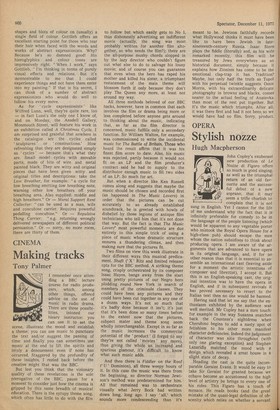THE ARTS
ART
Going the whole Hogarth
Evan Anthony
While it is highly unlikely that any divorce court would have accepted it as evidence of mental or any other kind of cruelty, the Picture of Frank Matthew Schutz being Sick does suggest that wifely bitchiness is not an exclusively twentieth-century Phenomenon. Here we have poor old Schutz in bed, wearing the latest eighteenth-century bed headgear, leaning O n one elbow, holding his head with the Other hand and looking glumly hungover as he reads a book. It seems that Mrs Schutz herself commissioned the painting "by way of reproving his drunkenness." We are in Hogarth land, and the savage eye of polaroid Bill may heighten or exaggerate, but it never lies as he details for us the life and times of merrie, corrupt, debauched, human, olde England.
The scope of the Tate's new exhibition Should satisfy the most avid of William Hogarth fans — conversation portraits (Assembly at Wanstead House, The Royal Family), scenes from the theatre • (The Beggars' Opera), modern moral subjects (A Harlot's Progress, A Rake's Progress), Portraits (Thomas Herring, Archbishop of Canterbury, David Garrick as Richard III), comic history (The Four Stages of Cruelty, An Election) — you name the genre and it is to be found in the drawing-room settings of this most complete show, containing over 200 works lent by Museums and private owners throughout this and other countries. It is a rich feast of Hogarthian detail, displaying the talent of a unique figure in the history of English art.
William Hogarth could well rival Scheherezade when it comes to telling stories; he didn't merely paint pictures — he painted (and etched, sketched and engraved) short stories and novels. Among the first of his breed to challenge the authority and dominance of foreign artists, he eminently succeeded and a visit to the Tate should, among other things, bolster the chauvinism of any Englishman whose chauvinism may be in need of some bolstering. By George, they don't make them like Hogarth anymore.
The satirical and comic works are, of course, what we expect from this artist. There is also The Shrimp Girl carrying the burden of being his serious masterpiece, and she does not stand alone in that category. Have another look at the picture of his servants, and at the marvellous redfaced portrait of George Arnold; it will be appreciated that as well as being a social commentator and deadly diarist, Hogarth had a number of fine moments as a painter of people — capable of delineating character as well as attitude.
Being considered a deadly social commentator is the reputation that Gerald Scarfe appears content to carry around with him, and seeing his work at The Workshop in Lambs Conduit Street, one gets the picture — relentlessly. But the vituperation is often so strong that the attach on political and sociological immorality impresses as being an end in itself. There are the easy laughs, certainly, and the studied outrageousness works — when it works — beautifully. As for technique, I sometimes have the very devil of a time deciphering who the devil is supposed to be.
A calmer view of the state of the nation (the physical state, that is) is offered by Francis Kelly, whose exhibition of English Landscape Etchings at the William Weston Gallery, Albemarle Street, accomplishes what Kelly claims to have set out to do: "I have chosen etched line to convey ... tranquility and timelessness. These are not the splendid familiar views but the quiet countryside ..." Perhaps it sounds rather too, calm, but it isn't dull. I can't say that I have particularly admired Kelly as a painter and, while I have found his recent aquatints interesting, nothing he has done had quite prepared me for the excellence of this delightful retreat to the mood of the nineteenth century.
Very much rooted in the twentieth century is the work of Adolph Gottlieb at the Marlborough Gallery, Albemarle Street. We are in the world of colour abstraction here, and this exhibition of Gottlieb's work from 1959 to the present illustrates a continued preoccupation with 'emblematic expressionism' — irregular shapes and blots of colour on (usually) a single field of colour. Gottlieb offers an excellent starting point for those who tear their hair when faced with the words and works of abstract expressionists. Why? Because he's so damned good! His hieroglyphics and colour tones are impressively right. "When I work," says Gottlieb, "I'm thinking in terms of purely visual effects and relations. But it's inconceivable to me that I could experience things and not have them enter into my painting." If that is his secret, I can think of a number of abstract expressionists who would do well to follow his every move.
As for 'cycle expressionists ' like Wilfred Lunn, well, they're quite rare, too — in fact Lunn's the only one I know of, and on Monday, the Ansdell Gallery, Monmouth Street, will feature his work in an exhibition called A Christmas Cycle. I am surprised and grateful that nowhere in the catalogue are the cycles called ' sculptures ' or ' constructions.' How refreshing that they are designated simply as cycles ' — because that's what they are. Small model cycles with movable parts, made of bits of wire and metal painted black. They are witty and original pieces that have been given witty and original titles and descriptions: take the Low Breather, for example: "a cycle for low breathing emitting low breathing note, warning other low breathers off your breathing area. Also supplied: middle and high breathers." Or — Moral Support Rent Collector: "can be used as a man, wife and concubine carrier. Requires powerful pedalling concubine." Or — Repulsive Thing Carrier: "e.g. returning wrongly delivered newspapers of different political persuasion." Or — sorry, no more room, there are thirty of them.











































 Previous page
Previous page